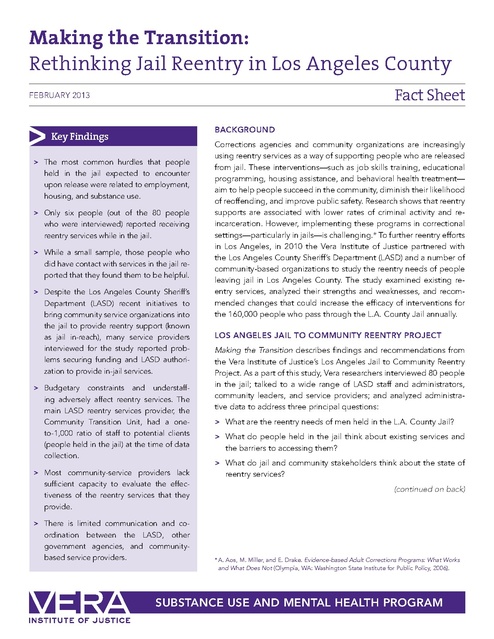Vera Inst Making the Transition Los Angeles Co Reentry Fact Sheet Feb 2013
Download original document:

Document text

Document text
This text is machine-read, and may contain errors. Check the original document to verify accuracy.
Making the Transition: Rethinking Jail Reentry in Los Angeles County Fact Sheet FEBRUARY 2013 BACKGROUND Key Findings >> The most common hurdles that people held in the jail expected to encounter upon release were related to e mployment, housing, and substance use. >> Only six people (out of the 80 people who were interviewed) reported receiving reentry services while in the jail. >> While a small sample, those people who did have contact with services in the jail reported that they found them to be h elpful. >> Despite the Los Angeles County Sheriff’s Department (LASD) recent initiatives to bring community service organizations into the jail to provide reentry support (known as jail in-reach), many service providers interviewed for the study reported problems securing funding and LASD authorization to provide in-jail services. >> Budgetary constraints and understaffing adversely affect reentry services. The main LASD reentry services provider, the Community Transition Unit, had a one to-1,000 ratio of staff to potential clients (people held in the jail) at the time of data collection. >> Most community-service providers lack sufficient capacity to evaluate the effectiveness of the reentry services that they provide. >> There is limited communication and coordination between the LASD, other government agencies, and community based service providers. Corrections agencies and community organizations are increasingly using reentry services as a way of supporting people who are released from jail. These interventions—such as job skills training, educational programming, housing assistance, and behavioral health treatment— aim to help people succeed in the community, diminish their likelihood of reoffending, and improve public safety. Research shows that reentry supports are associated with lower rates of criminal activity and reincarceration. However, implementing these programs in correctional settings—particularly in jails—is challenging.* To further reentry efforts in Los Angeles, in 2010 the Vera Institute of Justice partnered with the Los Angeles County Sheriff’s Department (LASD) and a number of community-based organizations to study the reentry needs of people leaving jail in Los Angeles County. The study examined existing reentry services, analyzed their strengths and weaknesses, and recommended changes that could increase the efficacy of interventions for the 160,000 people who pass through the L.A. County Jail annually. LOS ANGELES JAIL TO COMMUNITY REENTRY PROJECT Making the Transition describes findings and recommendations from the Vera Institute of Justice’s Los Angeles Jail to Community Reentry Project. As a part of this study, Vera researchers interviewed 80 people in the jail; talked to a wide range of LASD staff and administrators, community leaders, and service providers; and analyzed administrative data to address three principal questions: >> What are the reentry needs of men held in the L.A. County Jail? >> What do people held in the jail think about existing services and the barriers to accessing them? >> What do jail and community stakeholders think about the state of reentry services? (continued on back) * A. Aos, M. Miller, and E. Drake. Evidence-based Adult Corrections Programs: What Works and What Does Not (Olympia, WA: Washington State Institute for Public Policy, 2006). SUBSTANCE USE AND MENTAL HEALTH PROGRAM The Five Most Common Reentry Priorities Self-Reported by Interviewees Held in the Jail (n=80) employment 73% housing 34% substance use 33% relationships 26% staying out of trouble 23% For More Information The Vera Institute of Justice is an independent nonprofit organization that combines expertise in research, demonstration projects, and technical assistance to help leaders in government and civil society improve the systems people rely on for justice and safety. The recommendations in this report address three general areas for improvement: reentry service delivery and engagement; operations and efficiency; and coordination. They build on the ongoing efforts of the LASD and communityservice providers to enhance supportive services for people leaving the jail and returning to their communities. The report recommendations include: Reentry Service Delivery and Engagement 1. Expand reentry service outreach and tailor it for the jail environment. 2. Create client targeting and triage systems. 3. Incorporate risk and needs assessments into reentry services. 4. Individualize reentry service plans for maximum impact. 5. Take steps to overcome barriers to trust and engagement. 6. Strengthen linkages between the jail and community-service providers. Operations and Efficiency 7. Standardize the procedures, staff training, and supervision used by jailbased reentry programs. 8. Use data to facilitate reentry services provision. 9. Develop evaluation components for all reentry programs. Coordination 10. Enhance collaboration among reentry service providers, the Department of Mental Health, and the Probation Department. 11. Increase collaboration between and among jail and community-based providers. CONCLUSION Making the Transition is a starting point for conversations among LASD staff, community leaders, funders, government officials, and representatives of nonprofit organizations about the services people leaving the L.A. County Jail need most and how to improve their delivery. Read the complete summary report at www.vera.org/pub/makingthe-transition-summary-report Read the technical report at www.vera.org/pub/making-thetransition-technical-report For more information on the Substance Use and Mental Health Program, please contact Jim Parsons, at (212) 376-3043 or jparsons@vera.org. Vera Institute of Justice 233 Broadway, 12th Floor New York, NY 10279 Tel: (212) 334-1300 Fax: (212) 941-9407 Washington DC Office 1100 First St. NE, Suite 950 Washington, DC 20002 Tel: (202) 465-8900 Fax: (202) 408-1972 New Orleans Office 546 Carondelet St. New Orleans, LA 70130 Tel: (504) 593-0937 Fax: (212) 941-9407 Los Angeles Office 707 Wilshire Blvd., Suite 3850 Los Angeles, CA 90017 Tel: (213) 223-2442 Fax: (213) 955-9250

